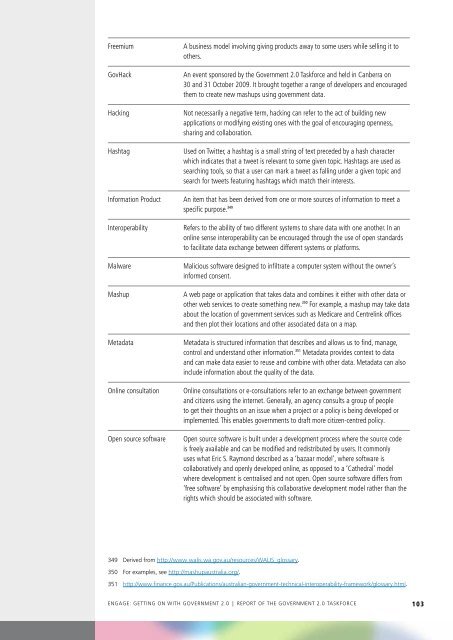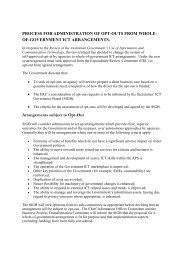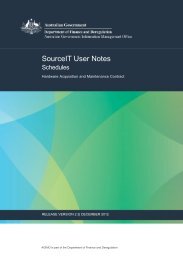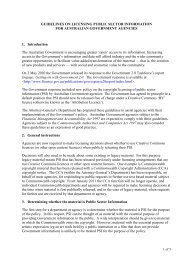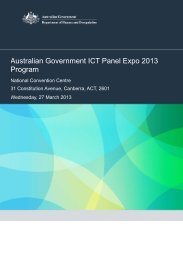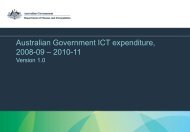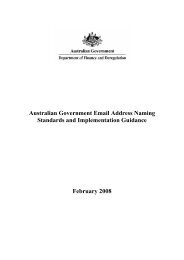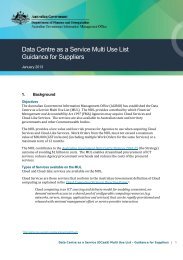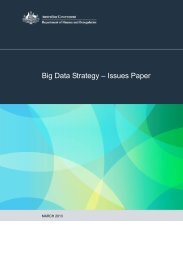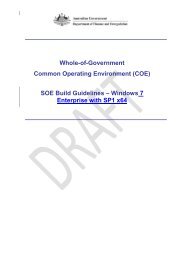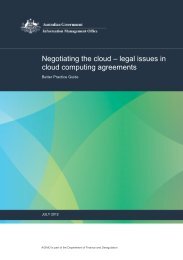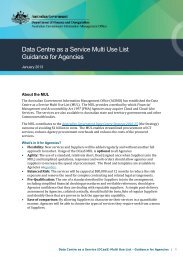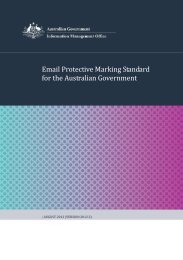Getting on with Government 2.0 - Department of Finance and ...
Getting on with Government 2.0 - Department of Finance and ...
Getting on with Government 2.0 - Department of Finance and ...
You also want an ePaper? Increase the reach of your titles
YUMPU automatically turns print PDFs into web optimized ePapers that Google loves.
<br />
Freemium<br />
GovHack<br />
Hacking<br />
Hashtag<br />
Informati<strong>on</strong> Product<br />
Interoperability<br />
Malware<br />
Mashup<br />
Metadata<br />
Online c<strong>on</strong>sultati<strong>on</strong><br />
Open source s<strong>of</strong>tware<br />
A business model involving giving products away to some users while selling it to<br />
others.<br />
An event sp<strong>on</strong>sored by the <strong>Government</strong> <strong>2.0</strong> Taskforce <strong>and</strong> held in Canberra <strong>on</strong><br />
30 <strong>and</strong> 31 October 2009. It brought together a range <strong>of</strong> developers <strong>and</strong> encouraged<br />
them to create new mashups using government data.<br />
Not necessarily a negative term, hacking can refer to the act <strong>of</strong> building new<br />
applicati<strong>on</strong>s or modifying existing <strong>on</strong>es <strong>with</strong> the goal <strong>of</strong> encouraging openness,<br />
sharing <strong>and</strong> collaborati<strong>on</strong>.<br />
Used <strong>on</strong> Twitter, a hashtag is a small string <strong>of</strong> text preceded by a hash character<br />
which indicates that a tweet is relevant to some given topic. Hashtags are used as<br />
searching tools, so that a user can mark a tweet as falling under a given topic <strong>and</strong><br />
search for tweets featuring hashtags which match their interests.<br />
An item that has been derived from <strong>on</strong>e or more sources <strong>of</strong> informati<strong>on</strong> to meet a<br />
specific purpose. 349<br />
Refers to the ability <strong>of</strong> two different systems to share data <strong>with</strong> <strong>on</strong>e another. In an<br />
<strong>on</strong>line sense interoperability can be encouraged through the use <strong>of</strong> open st<strong>and</strong>ards<br />
to facilitate data exchange between different systems or platforms.<br />
Malicious s<strong>of</strong>tware designed to infiltrate a computer system <strong>with</strong>out the owner’s<br />
informed c<strong>on</strong>sent.<br />
A web page or applicati<strong>on</strong> that takes data <strong>and</strong> combines it either <strong>with</strong> other data or<br />
other web services to create something new. 350 For example, a mashup may take data<br />
about the locati<strong>on</strong> <strong>of</strong> government services such as Medicare <strong>and</strong> Centrelink <strong>of</strong>fices<br />
<strong>and</strong> then plot their locati<strong>on</strong>s <strong>and</strong> other associated data <strong>on</strong> a map.<br />
Metadata is structured informati<strong>on</strong> that describes <strong>and</strong> allows us to find, manage,<br />
c<strong>on</strong>trol <strong>and</strong> underst<strong>and</strong> other informati<strong>on</strong>. 351 Metadata provides c<strong>on</strong>text to data<br />
<strong>and</strong> can make data easier to reuse <strong>and</strong> combine <strong>with</strong> other data. Metadata can also<br />
include informati<strong>on</strong> about the quality <strong>of</strong> the data.<br />
Online c<strong>on</strong>sultati<strong>on</strong>s or e-c<strong>on</strong>sultati<strong>on</strong>s refer to an exchange between government<br />
<strong>and</strong> citizens using the internet. Generally, an agency c<strong>on</strong>sults a group <strong>of</strong> people<br />
to get their thoughts <strong>on</strong> an issue when a project or a policy is being developed or<br />
implemented. This enables governments to draft more citizen-centred policy.<br />
Open source s<strong>of</strong>tware is built under a development process where the source code<br />
is freely available <strong>and</strong> can be modified <strong>and</strong> redistributed by users. It comm<strong>on</strong>ly<br />
uses what Eric S. Raym<strong>on</strong>d described as a ‘bazaar model’, where s<strong>of</strong>tware is<br />
collaboratively <strong>and</strong> openly developed <strong>on</strong>line, as opposed to a ‘Cathedral’ model<br />
where development is centralised <strong>and</strong> not open. Open source s<strong>of</strong>tware differs from<br />
‘free s<strong>of</strong>tware’ by emphasising this collaborative development model rather than the<br />
rights which should be associated <strong>with</strong> s<strong>of</strong>tware.<br />
349 Derived from http://www.walis.wa.gov.au/resources/WALIS_glossary.<br />
350 For examples, see http://mashupaustralia.org/.<br />
351 http://www.finance.gov.au/Publicati<strong>on</strong>s/australian-government-technical-interoperability-framework/glossary.html.<br />
Engage: <str<strong>on</strong>g>Getting</str<strong>on</strong>g> <strong>on</strong> <strong>with</strong> <strong>Government</strong> <strong>2.0</strong> | report <strong>of</strong> the government <strong>2.0</strong> taskforce<br />
103


